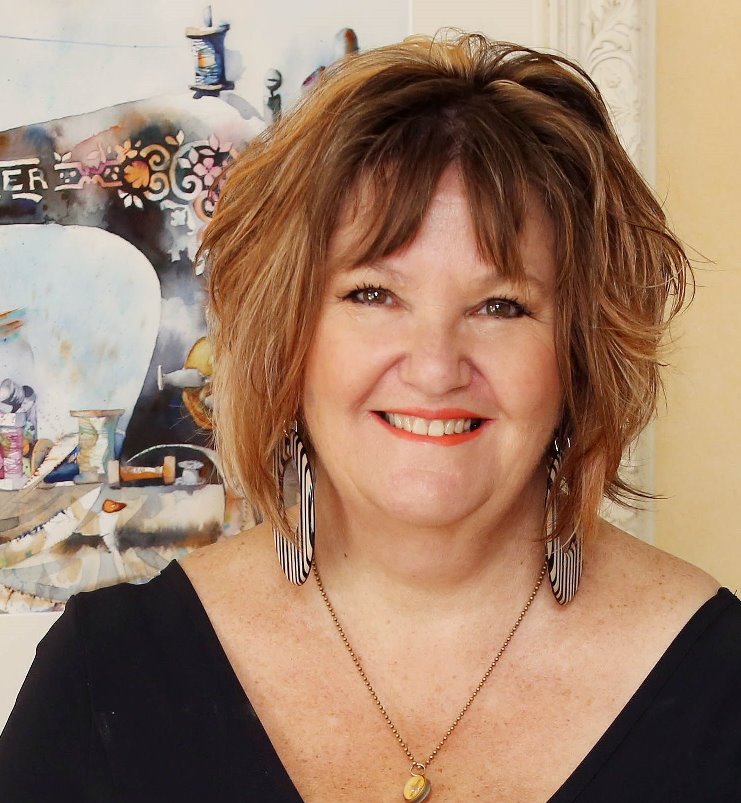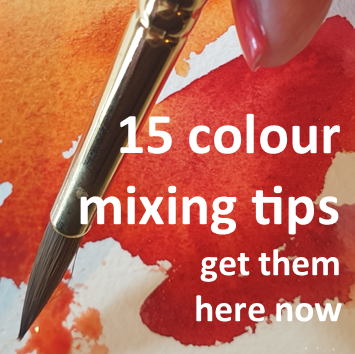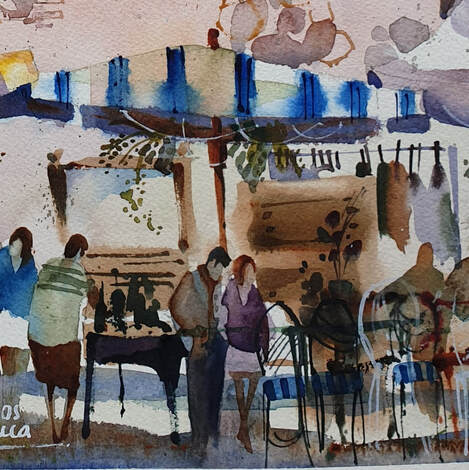
I received a very kind compliment recently, my paintings remind them of Dan Burt’s paintings. I’d never heard of Dan Burt but, man, I know his work now!! Totally amazing – PLUS totally incredible colour!!
This led me to think about the misconception about watercolour – that it’s wishy-washy, subdued, delicate and painted by Victorian ladies. YES 150 YEARS AGO!! We’re now in the 21st century and along with my peers, watercolours are now a contemporary medium painted in many styles. I’m known for my strong colour – that’s how I see the world, that how I want the world to be. I love the challenge of watercolour – it’s not for the faint of heart! If you’re happy to paint on the edge of your seat from time-to-time, watercolour is the best medium! Skydiving is not the only means to get an adrenaline rush! Many years ago I made a deliberate decision to paint stronger vibrant colour. It was a natural step for me, as I’ve always put unusual colours together. As I embarked on my professional artist’s journey, it seemed that, partly due to the lack of appreciation for watercolours back then, my work needed stronger colour to stand amongst the strong colours of opaque medium. A tiny 5ml tube of watercolour is confusing, how far will that tiny 5ml tube of paint go? Quite far if you are painting small once or twice a week, not far enough if you paint big every day. Buy artist’s quality paint and the little 5ml tube will go even further. This is going to sound strange but, buy 100% cotton rag paper and you will notice good quality paint goes even further and is more vibrant. A good practice for the watercolour painter is to start with a tiny amount of paint pigment and add water to make a nice puddle to paint with. Next build up some stronger colour with more paint and less water, then even more paint and much less water = DO NOT ADD MORE WATER, do not “clean” your brush between washes. Please note creating a large area wash is all about starting off with lots of water and then reducing the amount of water while you are increasing the amount of pigment. By dipping into your water pot too often, your brush’s water ratio will be out of whack and in danger of diluting your wash and creating blooms where you don’t want them. This practice will grow your understanding of water-to-paint-to-brush-to-paper ratios. Further the watercolour painter should be mindful of the same water-to-pigment ratio throughout the whole painting. Even with a good command of values, a watercolour can look insipid without a good variety of pigment strength. Another weapon in your armoury for vibrant colour is to remind yourself to lay down your colour confidently and then DON’T TOUCH IT! Hands in your pockets – walk away!! Continual fussing and excessive brushstrokes lead to dull colour. When glazing colour or layering colour, to add richness and vibrancy, consider using the same colours/pigments ie if you are painting a lemon, then paint the same colour in both washes. For example if I underpaint and let blue flow through my lemon and then the second pass (glaze) is yellow, my lemon is unlikely to be a bright saturate colour. I’m not saying it’s wrong, I’m saying think about your colours and how you want to use them, what you want to achieve. Add a good glob of fresh artist’s quality paint to your palette every week, let it set up overnight. Before you begin your painting session, give it a spritz of water and you’re good to go! Continual scrubbing at dry paint (aka bird poop = poor quality paint) will distract you from creating. It’s imperative to use the right brush for the job at hand. A small brush will not help you to lay down a sky wash – it won’t hold enough water to form a bead, your previous marks will dry too soon and you’ll end up with brush marks and blooms. For beginners, too big a brush with a good point and fat belly will do a good job for you. Practice with it and learn how to use it, with a good brush it is possible to paint a whole painting, start-to-finish, with just this one brush. ciao cari pittori let me know what you think in the comments below!!
10 Comments
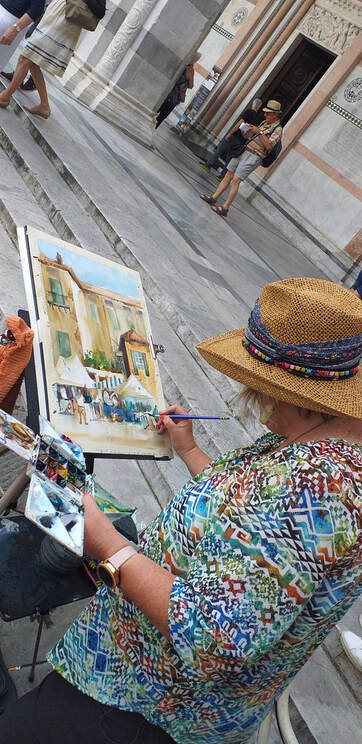
There’s nothing easy about painting watercolour en plein air but, for me, it is an exhilarating and fun experience.
My early attempts, however, were difficult and my paintings absolutely atrocious! It seemed to take me forever to get to grips with this new style of painting in the great outdoors. Without realising, I was faithfully following the 80/20 rule, 80% observation 20% drawing /painting. Later it dawned on me: this rule does not apply to painting watercolour en plein air - I was trying to follow a guideline for the constant situation of studio/observational drawing. When painting in the field, from the time you select your subject to your end-game, you have about 1-1.5 hours, 2 hours at most, to capture the subject before light and atmospheric conditions change too much. No mean feat but, if you practice, you will improve every time. Another element to consider is the subject. My first attempts at painting en plein air were with groups of artists who love painting landscapes. For me, it was a big problem. Although I love good quality landscape paintings, I’m not interested in painting them myself. I’m a city girl afterall, I’m attuned to light and shadows bouncing around architecture and the people who inhabit amazing spaces. Just think of Lisa Douglas (Eva Gabor) and you'll have hit your nail on the head! I often tell my students to slow their painting process down but in the case of painting watercolour en plein air, I’m going to contradict myself and tell you to speed up! Speed up so you catch the light and changing conditions, Remember, watercolour is a fast medium. Give yourself 5 minutes, and only 5 minutes, to take photos and sketch 1 or 2 value thumbnails and most importantly, take a mental snapshot. Make your memory work for you and, even if you think your result is "wrong", your work will be formed of the essence of your subject. Perfetto!! What a great excuse to go out and paint it again!! Your next work at the same scene will include different features and details and the next different again. My personal strategy is to map the subject onto my watercolour paper with a 5 minute sketch and then not refer to the actual scene again, even if I have to turn away from it. I am painting my interpretation of the scene not a photograph. Changing light and shadows become mighty confusing and create confusing paintings. Learn the tools you need to assist you:
x 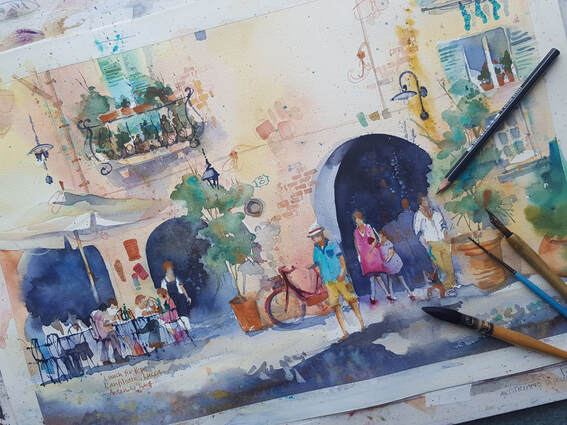 "Lunch for Pepe" "Lunch for Pepe"
Although most paintings come to a natural conclusion, we all ask ourselves "is my painting finished yet?"
I have heard it said that "Your painting is finished before you have" meaning we should stop painting, stop fiddling!! Further, by spending more time planning your painting and drawing "finished" value studies and sketches and then painting to those sketches and plans, you will find that "finishing" just seems to happen - your works will come to a natural conclusion. On occasion, however, there will still be a work that takes longer to complete; it is 99.9% done but what is that final stroke? How do I decide if my work is finished? Remember, sometimes we need time to make all these decisions, your painting does not have to be finished right now! These are some of the questions I ask myself when I am hedging around: Unity: does the artwork looked unified? In other words, does every element link to every other element in the painting? For example an orange pumpkin may not work in a painting with a car as the main subject. But it might if the car was parked in a pumpkin field. Does the artwork seem complete? is there anything that jumps out at it you? Contrast: is there enough contrast? Is the darkest dark placed next to the lightest light in the focal area? What other contrasts are relevant to this piece of art? are there enough soft edges? are there enough hard edges in the focal area? Dominance: is there one shape, mark or colour that is dominant over all the others? What additional shapes, marks or colours are required to reinforce the dominance? Repetition: are there any colours, shapes or marks that seem isolated? Where could they be repeated to provide greater balance? Harmony: does the artwork have a sense of harmony? Linked to unity, harmony provides a sense of equilibrium. For example harmony can be achieved by using a limited palette. is the style of all the marks and shapes similar? Eg, is there a shape that is painted based on your sense of realism but the rest of painting includes mostly abstracted shapes? Ie, do all your shapes have similar attributes? Balance: is there good use of BIG, medium and small. Does the overall composition design work well? Are all opposing forces balanced? does it feel balanced? does your eye keep moving to a spot of nothing in the painting and then stop? Gradation: a sequence of blending from one extreme to another providing harmony and contrast. For example, the sequence of steps between the lightest light and the darkest dark is as important as the juxtaposition of contrasts. If that last wee gem is not answering itself quickly enough or your eye doesn’t pull directly to your focal point, put the painting away for a couple of weeks and then cast fresh eyes over it - the answer will very likely present itself to you. Sometimes, I leave a work in my studio or living room so i can see it as I'm moving about and seeing the same issue over and over again!! do feel free to comment or ask a question! Happy Painting!! |
AuthorPaintBox Tips, secrets, random thoughts, Poetry in watercolour is made in the freedom of the here and now. Amanda Brett Inspiration exists, but it has to find you working - Pablo Picasso There are no mistakes in watercolour, just some extra surprises!! Categories
All
What my readers and viewers have to say
Your emails are so informative! I must confess I've watched a couple of your demos from beginning to end, and it makes me want to watercolor!!! I've only ever painted with oil or acrylics and haven't know how to begin with WC. Your content is excellent!
Susan VN Hi Amanda
Thank you for your tips. They inspired me to practise and I realised I haven’t been loading the brush properly. I learnt about adding more paint, and not water, to washes. In today’s tips I like the idea of painting with purpose. Your tips are very helpful. I very much appreciate receiving them. Elizabeth Hi Amanda I enjoyed your post and generous tips. Looked up Dan Burt I begin to see that you can colour any subject to give it pizazz so long as the tone and form is correct Certainly adding value now to my attempts Thanks heaps Annie
Yes very wise words. Agree with not fussing and agree with comments about good quality paint. Well written and inspirational as always. Cheers Janet xxxx Archives
July 2023
Copyright © 2022 All images and text on Amanda's blog and website are the the legal property of Amanda Brett and may not be reproduced without express permission from Amanda Brett or her authorised agent. Thank you for respecting her art and the livelihood of all artists.
|



